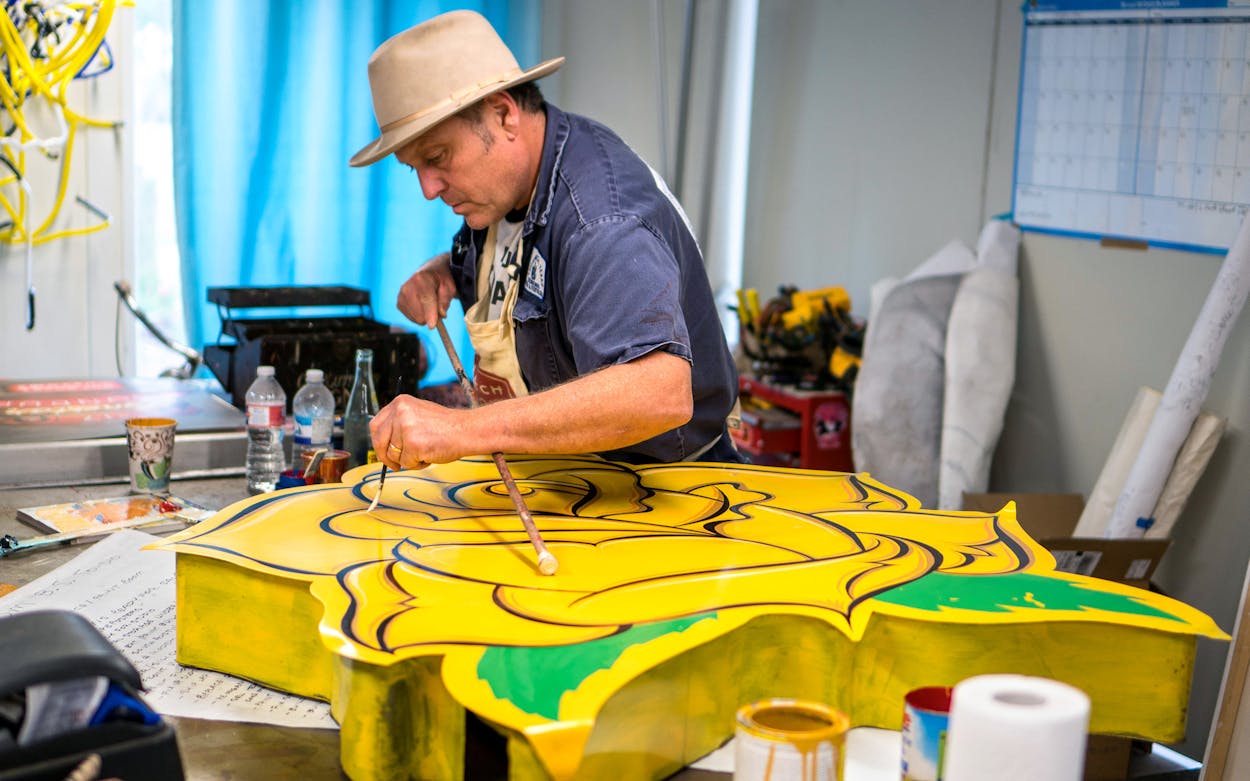There is a look and feel to the old, mythic version of Austin that holds space within the collective memory. It goes something like this: Guy Clark on the radio, artists abounding, and the bright lights of a not-so-big city beckoning a kid from East Texas with an artist’s temperament.
Neon Road, a new book by Austin-based neon artist Todd Sanders, is shot through with such sentiment. Featuring a twangy nostalgic reverence for the city that inspired him, the self-published art book curates Sanders’s story—from Montgomery to Austin, from commercial sign maker to successful artist—alongside sketches and photographs of his colorful “modern-vintage” displays. Sanders’s aesthetic is familiar to anyone who has spent time in the city, where he has produced neon and hand-painted signage since the mid-nineties. In an ode to one of Austin’s watering holes, he created a sign for Deep Eddy swimming pool featuring an animated neon diver. Other pieces advertise live music or feature neon cowgirls and -boys in pinup-style illustrations. (One display glorifying barbecue even graced the cover of this magazine.) At one point, his signs hung over at least thirty establishments in town. As he puts it, today, “if you’re going to open a place [in Austin], you need a rusty, brand new sign.”


Likewise, his South First Street gallery Roadhouse Relics has become a local fixture, with one wall bearing the famous “Welcome to Austin” mural and landmark. Among esteemed Texas collectors, his work is prized: Willie Nelson sought a neon horseshoe for Luck Reunion, Miranda Lambert ordered a jar full of neon fireflies at her first wedding, and ZZ Top called on Sanders to create a vintage BBQ sign for the cover of Chrome, Smoke & BBQ. The band’s lead singer, Billy Gibbons, counts himself a friend of Sanders’s and wrote the book’s foreword.
The coffee table book collects images of these works and more, alongside original sketches and photos of the artist, his process, and his loved ones. And between the bright colors and cheery snapshots, Sanders unwinds his story in a folksy, artist-next-door kind of tone that makes for a breezy read.
Neon Road arrives on the hundredth anniversary of neon’s arrival in America, introduced to this continent by a Frenchman via—what else?—advertising signage. But the real catalyst for the book was the death of Sanders’s father, Richard Sanders, two years ago. The elder Sanders features heavily in his son’s self-mythology, and consequently the book: first as a naysayer, questioning Sanders’s artistic path and condemning his choice to purchase his now iconic South First Street gallery, and finally as a creator in his own right. In the later years of his life, Sanders’s father made metal sculptures, including an eleven-foot-wide longhorn, and helped cut the metal backings for his son’s neon art. “It was one of the most moving experiences of my life” to hear his father refer to himself as an artist for the first time, says Sanders. The book’s other special guests include Hondo, a Chow–Saint Bernard mix and loyal sidekick who’d prowl Austin’s late-night streets with Sanders looking for signs in need of repair, and Sarah, Sanders’s wife of fifteen years who met the sign maker after wandering into his gallery to commission art.
“This idea of being an artist,” aided by his father’s change of heart, is a theme throughout the book. Decades into his career, Sanders still seems lit up by the notion that he simply gets to make stuff—and for a living! Though he admits the artist’s life is no longer quite achievable in the Austin he came up in, he says, “I cannot imagine a better life for someone.”








